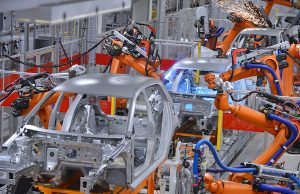Since the days Henry Ford first introduced the assembly line in the early 1900’s, the automotive industry has led the way in regards to manufacturing technology.
Increased complexity in today’s automobiles increases the chances for production errors, and the manufacturers can ill afford such errors in such a highly competitive market. They must ensure that they are meeting the standards that are demanded by the NHTSA (National Highway Traffic Safety Commission), and the trends in the consumer sector as well. To accomplish both, the use of industrial robotics and machine vision in the auto industry is growing by leaps and bounds.
Within the auto industry, machine vision is used in a variety of applications that primarily involve inspections and robotic guidance. With the use of embedded vision sensors that find objects in 2 or 3-dimentional space, the industrial robotics can adjust the path for the positioning of the objects. The robots rely on machine vision to guide them to reach far greater accuracy in critical activities including picking parts out of racks, bin picking and the positioning of said parts (such as doors and panels) for assembly.
The manufacturers are seeing the benefits of saving time, increased accuracy and higher levels of safety at their facilities. The use of industrial robotics and machine vision technology is literally found everywhere within the auto industry.
In fact, numerous machine vision technologies are being deployed in todays’ automotive inspection applications. This includes 3D imaging, barcode reading, multi-camera systems, smart cameras, and line scan cameras.
There’s a growing trend towards the use of 3D machine vision in the manufacturing facilities. The majority of visual guidance technology for manufacturing robots has been, up to now, 2 dimensional, but the trend is moving towards 3D machine vision and imaging.
3D vision technology can be used in a wide range of inspection applications. Some of which are:
- advanced automation
- lot tracking
- quality control
- component traceability
- gauging critical dimensions
- robot guidance
- DOT compliance
Any industrial robotics system that has been upgraded with 3D vision capability will function accurately, offer real-time position information, allowing it to precisely target and grab a piece on an assembly line whether it is flat on a conveyor belt, hanging, or upright. 3D vision allows the robot to deal with variations from known product dimensions giving it a new level of independence and versatility.
To continue to meet the growing demands, developers have designed sophisticated systems that comprise many cameras mounted on a fixed frame that are positioned to capture various images of the individual part and product for quality assurance purposes.
Not only are such vision inspection stations highly effective at detecting defects of subassemblies on automotive production lines – typically done within seconds – but today’s automakers are demanding an even more flexible approach in vision inspection process to address the increasing number of product variants.
With the increased demands felt across the auto world, the vision systems are getting more and more advanced. As they become more advanced, the precision lens built into the systems must also become more accurate. At Universe Optics, we meet those demands. We have a full array of lenses in stock, or our design team can engineer one to meet your specifications. We look forward to working with you.